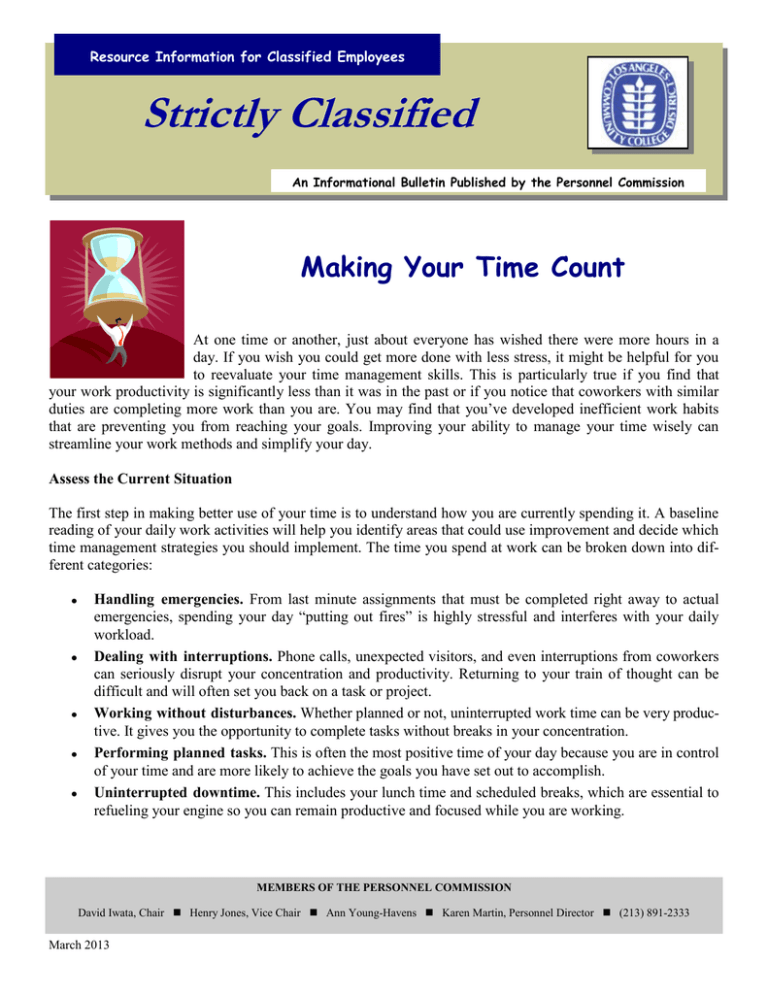Strictly Classified Making Your Time Count
advertisement

Resource Information for Classified Employees Strictly Classified An Informational Bulletin Published by the Personnel Commission Making Your Time Count At one time or another, just about everyone has wished there were more hours in a day. If you wish you could get more done with less stress, it might be helpful for you to reevaluate your time management skills. This is particularly true if you find that your work productivity is significantly less than it was in the past or if you notice that coworkers with similar duties are completing more work than you are. You may find that you’ve developed inefficient work habits that are preventing you from reaching your goals. Improving your ability to manage your time wisely can streamline your work methods and simplify your day. Assess the Current Situation The first step in making better use of your time is to understand how you are currently spending it. A baseline reading of your daily work activities will help you identify areas that could use improvement and decide which time management strategies you should implement. The time you spend at work can be broken down into different categories: Handling emergencies. From last minute assignments that must be completed right away to actual emergencies, spending your day “putting out fires” is highly stressful and interferes with your daily workload. Dealing with interruptions. Phone calls, unexpected visitors, and even interruptions from coworkers can seriously disrupt your concentration and productivity. Returning to your train of thought can be difficult and will often set you back on a task or project. Working without disturbances. Whether planned or not, uninterrupted work time can be very productive. It gives you the opportunity to complete tasks without breaks in your concentration. Performing planned tasks. This is often the most positive time of your day because you are in control of your time and are more likely to achieve the goals you have set out to accomplish. Uninterrupted downtime. This includes your lunch time and scheduled breaks, which are essential to refueling your engine so you can remain productive and focused while you are working. MEMBERS OF THE PERSONNEL COMMISSION David Iwata, Chair Henry Jones, Vice Chair Ann Young-Havens Karen Martin, Personnel Director (213) 891-2333 March 2013 Identify Where Time is Being Wasted and Make Changes The next step for making your time count is to find areas in need of improvement and make appropriate adjustments. Here are common examples of the ways we waste time at work and how to remedy them: Duplicating work. A great example of duplicating your work is reading emails in the morning, but putting off responding to them until later in the day. Doing this wastes time when you inevitably reread the email before responding. Instead of procrastinating on email responses, set designated times to check and respond to your emails, such as first thing in the morning and 3:00 in the afternoon. This will also help you resist the temptation to disrupt your own work by constantly checking your inbox. Searching for misplaced items. Many people lose time at work trying to locate misplaced files or paperwork. Establish an efficient organizational system and stick to it so you can find things easily when you need them. Avoiding clutter and maintaining order in your computer files and filing cabinets may save you more time than you realize. Think about it: you can easily waste 30 minutes a day searching for lost items if it takes you 3 minutes to search for one item and you do this 10 times a day. Socializing with others. It’s normal to make the occasional personal call or exchanging chitchat with a coworker. However, if you’re struggling to meet deadlines, you need to look at how much time you’re spending socializing. Try your best to limit social activities to your lunch and break times. Starting and stopping work. Although some projects simply cannot be completed in one sitting, constantly starting and stopping your work will severely stretch out the time it takes you to finish it. Make every attempt to set aside large blocks of uninterrupted time to work on big projects or reports. Deciding what to do next. Creating a to-do list is an important step in time management; however, it’s not enough just to know what you need to get done. You should also assign priorities to each item on your list. An easy system is to give each task a priority level of 1, 2, or 3, with 1 being the highest priority and 3 being the lowest. This will help you easily identify which tasks should take precedent over the others. Remember to reassess your priorities each day, because a task may shift in priority as time goes on. It’s also crucial to discuss your work priorities with your supervisor to make sure you’re both on the same page. Spending too much time on tasks. Set goals for yourself, both long-term and short-term, and give yourself a deadline for accomplishing those goals. Make sure to set realistic and attainable goals with appropriate timeframes. Creating goals that you cannot meet is just setting yourself up for failure. Instead, make them challenging yet achievable and then do your best to adhere to them. Once you establish good time management practices, make them a habit. Maintaining a steady routine will make keeping to your schedule automatic. If you find that no matter what you do, you are unable to keep up with your work and make important deadlines, then seek assistance from your supervisor or coworkers. It’s better to ask for help than to keep falling further and further behind. Lastly, don’t forget that your downtime, such as breaks and lunch, can be just as important to productivity as working time. Work hard, but don’t forget the importance that recharging yourself has on your ability to stay focused, make sound decisions, and keep your energy levels up throughout the day.



